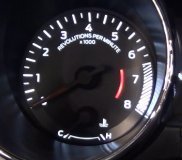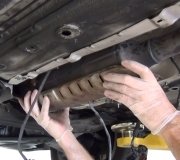Hi,
Based on your description, it sounds like a weak fuel pump or plugged filter. It will rev easily without a load on the engine. With a load, more fuel is required, so I have a feeling your diagnosis is correct.
What I suggest is to simply check fuel pressure. Here is a link that shows how it is done in general:
https://www.2carpros.com/articles/how-to-check-fuel-system-pressure-and-regulator
Here are the directions and specs specific to your vehicle:
1992 GMC Truck K 1500 Truck 4WD V8-350 5.7L
Fuel System Pressure Test
Vehicle Powertrain Management Fuel Delivery and Air Induction Fuel Pump Fuel Pressure Testing and Inspection Component Tests and General Diagnostics Fuel System Pressure Test
FUEL SYSTEM PRESSURE TEST
PROCEDURE
A fuel system pressure test is part of several of the Diagnostic Charts and Symptom Checks. To perform this test, follow this procedure:
Note: To perform residual pressure check refer to: Fuel Pump, Testing and Inspection.
1. Turn engine OFF to relieve system pressure.
- Disconnect negative battery terminal to avoid possible fuel discharge if an accidental attempt is made to start the engine.
- Loosen fuel filler cap to relieve tank vapor pressure.
- The constant bleed feature relieves fuel pump system pressure when the engine is turned "OFF".
2. Uncouple fuel supply flexible hose in engine compartment. Install fuel pressure gauge between steel line and flexible hose.
3. Tighten gauge in line to insure no leaks occur during testing.
4. Connect negative battery terminal and START engine and observe fuel pressure reading. It should be 62-90 kPa (9-13 psi). If not, refer to DIAGNOSTIC CHARTS/FUEL SYSTEM PRESSURE TEST (CHART A-6).
5. Turn engine OFF to relieve system pressure.
- Disconnect negative battery terminal to avoid possible fuel discharge if an accidental attempt is made to start the engine.
- Loosen fuel filler cap to relieve tank vapor pressure.
6. Remove fuel pressure gauge.
7. Install new O-ring on fuel feed line. Reinstall fuel line.
8. Connect negative battery terminal and START engine and check for fuel leaks.
9. Install air cleaner assembly.
________________________
Next, in the event the pressure is within spec, I recommend retrieving diagnostic trouble codes. This truck has an OBD1 system. A scanner isn't needed. All you need is a short jumper wire or even a paper clip. Here is a link that explains how it is done:
https://www.2carpros.com/articles/buick-cadillac-chevy-gmc-oldsmobile-pontiac-gm-1983-1995-obd1-code-definitions-and-retrieval-method
_______________________
Let me know what you find or if you have other questions.
Take care,
Joe
Friday, February 7th, 2020 AT 7:58 PM


